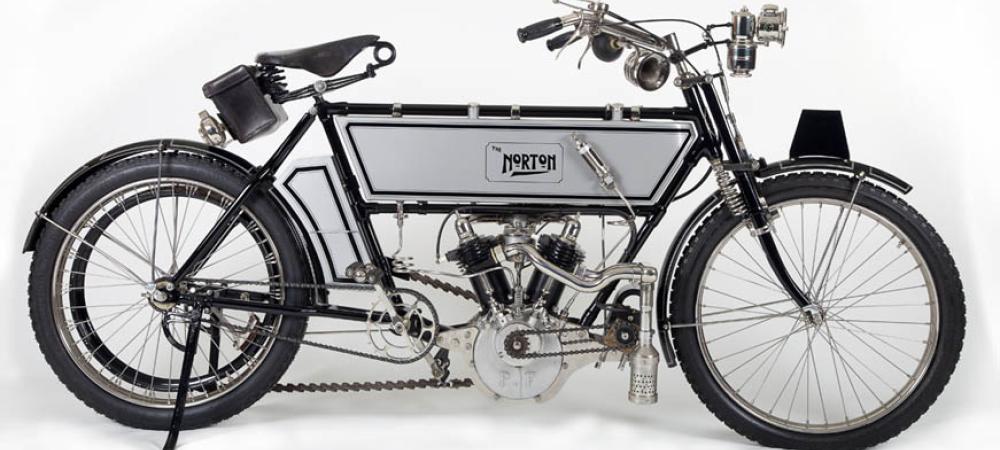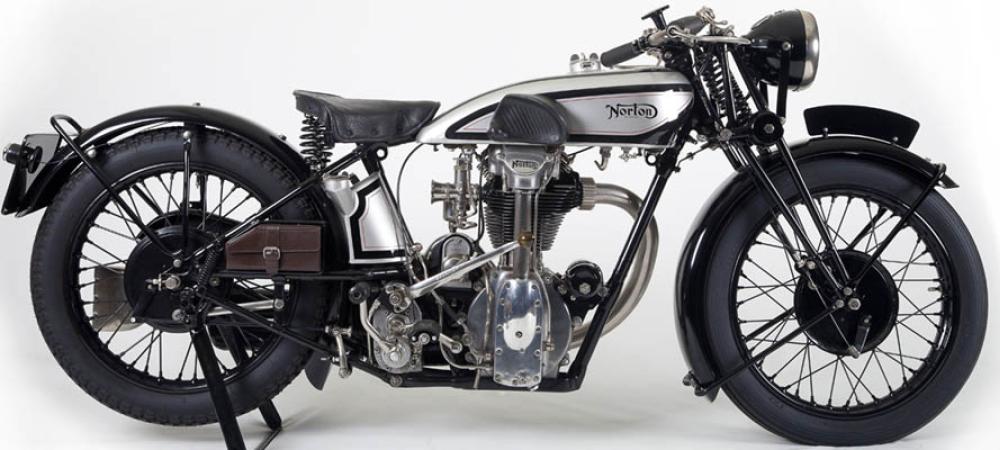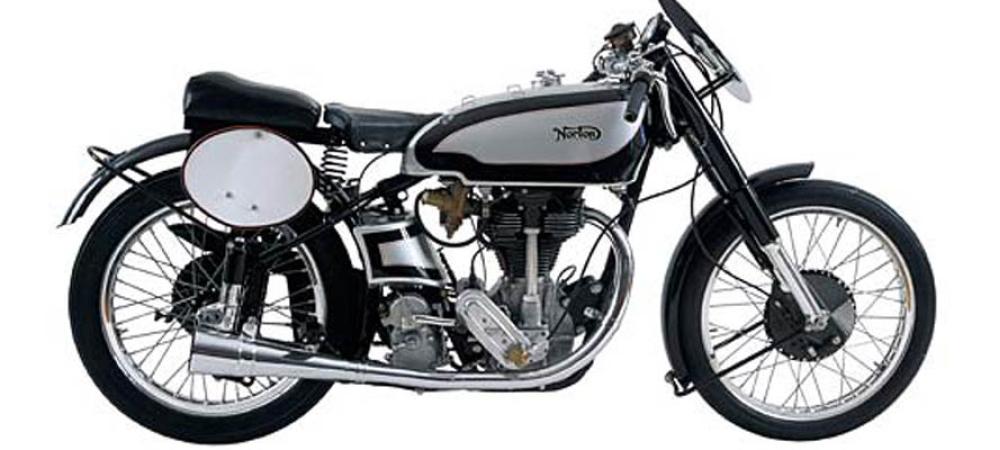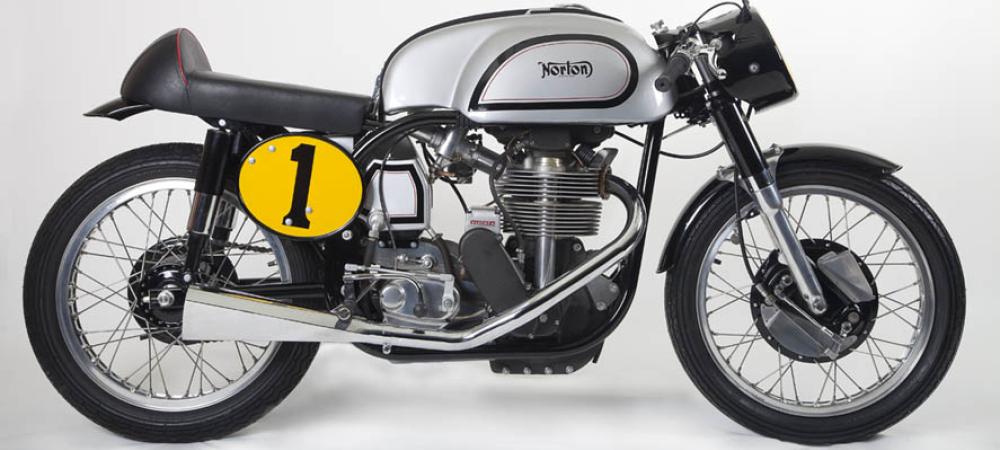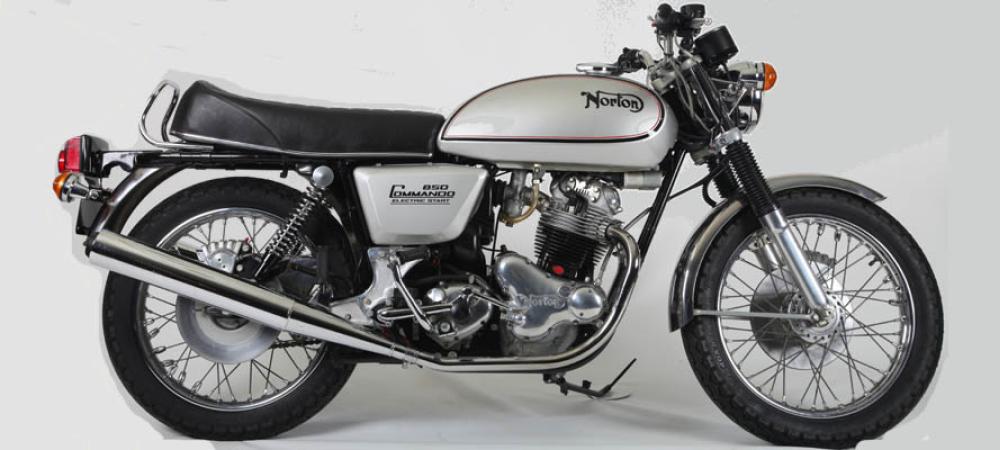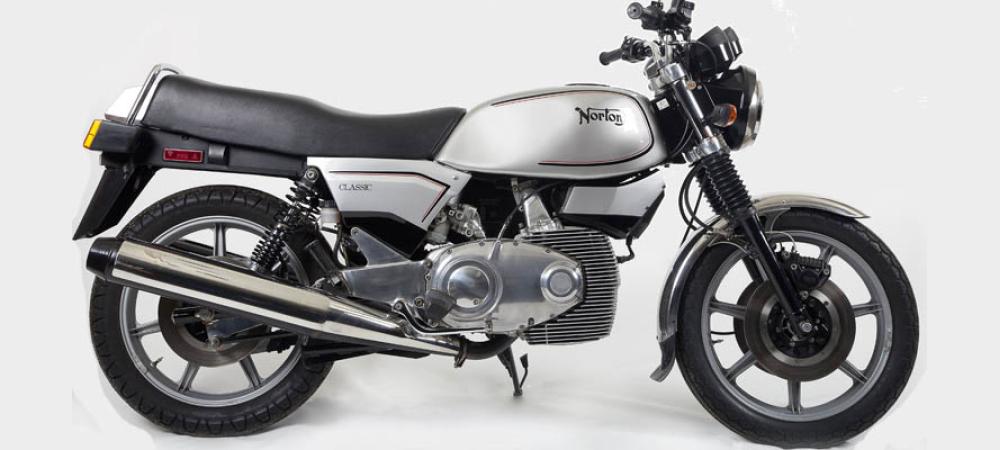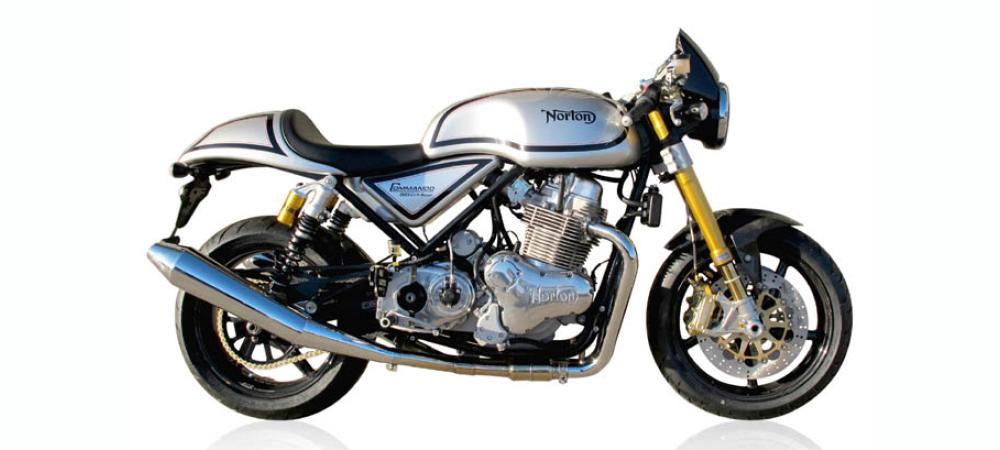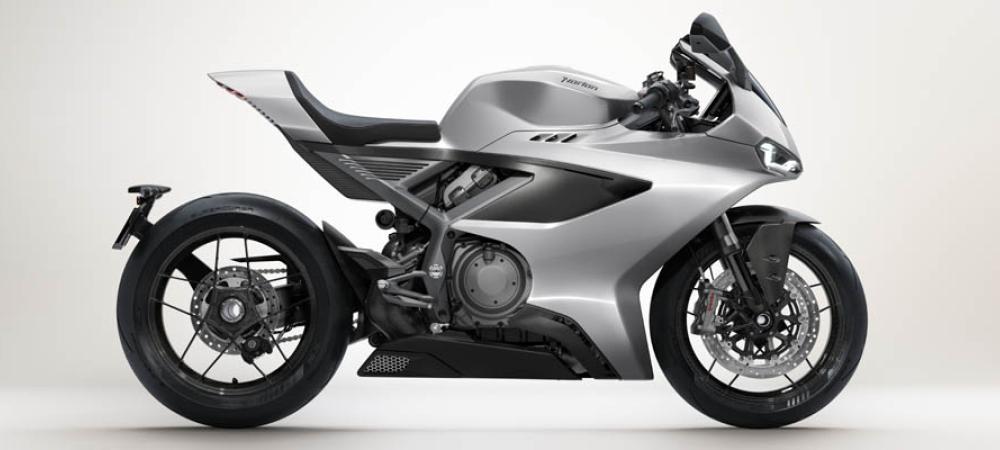THE NORTON ROTARY
One of the more interesting aspects in recent times of Norton's long and sometimes chequered life, ('Pa' Norton started his Birmingham based business in 1898, thus surely making it one of the oldest motorcycle companies) has been its excursion into the development and manufacture of the rotary (Wankel) engine.
How, why, when and where did Norton get involved with this unusual engine? Tony Denniss traces its fascinating history.
In the 1960's the world automotive industry saw Dr. Wankel's engine as a potentially serious competitor to the reciprocating engine. They studied it and many took out licences from NSU/Wankel and started development programmes which culminated for a variety of reasons in most activity starting around the time of the first oil crisis in 1973. The major Japanese motorcycle manufacturers of Yamaha, Suzuki and Kawasaki also became NSU/Wankel licencees and started hectic development programmes, resulting in Suzuki taking the plunge with their RE5 model.
In 1969 the B.S.A. Group Research Centre felt that there could be a market for this type of engine in motorcycles because of its simplicity, low vibration and weight, and compactness.
Therefore they engaged the services of a young Cambridge graduate engineer named D.W. Garside, one time employee of Rolls Royce Motors, to take on this project at the Group Research Centre, Kitts Green, Birmingham. Initially he had only one engineer and two fitters to assist him. A preliminary market survey was carried out which indicated that a rotary powered motorcycle could succeed at the high powered end of the super bike market and compete with the complex multicylinder motorcycles being offered at the time. Garside's initial target, therefore, was to develop an engine producing 50 to 60 b.h.p., his first basic design choices being:-
(a) Air or water cooled housings
(b) Charge or oil cooled rotors
(c) Number of rotors
Water cooling appeared to be attractive as adequate cooling would be assured, particularly around the spark plug and exhaust port area. In the end it was rejected as being unacceptable to potential customers as water cooling was still rare in those days and it was anticipated (subsequently proved to be wrong) that a weight penalty would result.
Today, when water cooling is commonplace, a different decision would have been taken. Indeed, the current Commander, J.P.S. racer and the Norton aircraft engines are all water cooled.
The starting point for research was a KM914 Fichtel & Sachs forced air-cooled single rotor engine of 300cc and developing 18 B.H.P. First reaction to this engine was the technical simplicity and compactness of the charge cooled rotor, compared with the oil cooled rotor type, although the low specific power output with this type of cooling would be insufficient for motorcycle applications. Garside therefore decided that a system which retained the compactness of this design, but allowed for much greater power potential was required. More about his ingenious solution later.
Performance of the F & S engine, including heat rejection rates, were fully mapped and the results compared with the air cooling availability on a motorcycle. Practical tests were carried out on a motorcycle at M.I.R.A. using pilot tubes and wool tufts. These tests confirmed that air speed behind the front wheel was approximately half that of the machines forward speed, Although many of the B.S.A. machines then being built had only 20 square inches per b.h.p. of finning, it was generally recognised that 40 square inches per b.h.p. was the accepted norm. The F & S engine had about 50 square inches per b.h.p. and Garside felt that a twin rotor version of this engine, mounted low in a motorcycle with the rotor shaft axis mounted transversely across the frame, would be adequately cooled. Also, the twin rotor housings would be positioned either side of the front wheel centreline where the cooling air would be less disturbed. So this together with deep circumferential finning and sloping the major axis 15 degrees to the rear, thus placing the hot sector of the trochoid between the spark plug and exhaust port directly in line with the air flow, should provide a satisfactorily cooled engine and allow considerable potential for further power development. In addition, this angle would conveniently allow the inlet and exhaust pipes to pass over and under the gearbox. A twin rotor development engine was then built based on this design using F & S dimensions and rotors.
By 1970 the design was showing such promise that Garside was transferred to Umberslade Hall where the B.S.A. Group's motorcycle development and testing facilities were located.
Here, Garside set about developing his ideas in retaining the compact charge cooled system, but overcoming its inherent power deficiencies. Although the charge cooled rotor system allowed a very simple construction, it resulted in low BMEP, due to charge heating and the long tortuous path through the rotor passages and ports limiting breathing at higher r.p.m. He noted that some other designs increased the BMEP by passing a proportion of the induction air directly into the working chamber. However, this method resulted in reduced rotor cooling. Now the colour and carbon deposits in the F & S engine indicated that rotor cooling was already marginal, despite forced air cooling and rich mixture. This system, therefore, did not endear itself to Garside. So he carried out an experiment of passing the heated mixture emerging from the rotor passageways, through an air to water inter-cooler before passing the mixture into the induction chamber. This showed some improvement but would not be practical on a motorcycle. Therefore he replaced the intercooler with a plenum chamber of about 5 litres capacity, which worked equally well.
However the major step forward came when the carburettor was repositioned between the plenum chamber and induction pipe so that air only, not the mixture, passed through the rotor. The result was that a single rotor engine of this configuration produced some 38 b.h.p., about 85% more than the original F & S unit, progress indeed .
This marked increase in power was almost entirely due to improved volumetric efficiency brought about as follows:-
(a) The plenum chamber modified the intermittent working chamber intake flow to a more continuous one, through the restrictive rotor and side plate passages. It also acted to some degree as an intercooler reducing the temperature by approximately 20°C.
(b) The repositioning of the carburettor resulted in the latent heat of evaporation of the fuel being utilised at a more favourable point, giving a lower mixture temperature. (c) The position of the carburettor also allowed a tuned length of induction pipe to be chosen.
(d) Increasing the quarter moon shaped port in each end plate from one to two allowed greatly increased air flow at any rotor shaft angle.
However, there were penalties with these changes; first the additional bulk of the plenum chamber and additional ducting, and secondly the petrol oil mixture was no longer possible, a separate pump and oil system being required.
It became apparent at a later date that a sheet metal spine frame which would incorporate the plenum chamber and oil tank would be a very neat solution and incidentally, the plenum chamber would act as a very effective intake silencer.
Garside found that there were other advantages with this system in that the rotor cooling temperatures remained stable in spite of the increased power. These were found to be as a result of the following:-
(a) The available induction cooling air is used more effectively by being passed more slowly through several passages in parallel rather than through one passage intermittently at high velocity.
(b) The lower final charge temperature reduces gas temperatures throughout the cycle and thus reduces heat input through the rotor flanks.
(c) The cooling air passing through the rotor passages has a higher density than the petrol/air mixture which is of reduced density as used in alternative systems.
The system provided near automatic balance for all load and speed conditions. Any increase in power output and therefore heat input to the rotor, whether due to r.p.m. or BMEP increase, was simultaneously balanced by a corresponding increase in air volume through the rotor ports. Furthermore, any weakening of mixture to optimise fuel economy did not affect rotor temperature as any increase in heat input was offset by an increase in airflow. Overall, this system proved to provide a very compact design, with low frictional losses, few moving parts and reasonably low production costs.
However, storm clouds were on the way. Garside's engine may have been showing much promise, but B.S.A. bike sales were going through a disastrous period. Funds were needed urgently so in 1972 B.S.A. became part of Norton Villiers, under the chairmanship of Mr. R. D. Poore. He quickly saw the advantages of the Rotary engine and moved it when Umberslade Hall was closed, together with certain key engineers, back to Kitts Green, Birmingham. Here further development, mostly related to improved reliability and durability, was carried out. Two machines were built using a sheet metal chassis to assist in development.
In August 1975 the N.V.T. Group of Companies failed. However, Poore had had the foresight to retain the Rotary project, which was moved - again with Garside and other key personnel, to a small modern factory at Shenstone, near Lichfield, Staffordshire. A small team now set about designing, under the overall control of R.V. Trigg (later to move to Yamaha), the definitive machine, which utilised the now familiar sheet metal frame, Marzocchi forks, Brembo brakes and the distinctive styling which became the hallmark of the rotary Norton until 1988.
Some of the detail developments are interesting to recall. For example, it was found that the forged steel rotor shaft journal diameters, which are casehardened, grew in diameter during the first few hours of use due to the high temperatures developed in these early engines. It was only after a cryogenic treatment was introduced into the production process that this problem was overcome.
The rotor housings are cast in LM9, an aluminium chosen for its low copper content which allows good adhesion of the Einisil plating. This nickel Silicon plating provides a very hard surface which is entirely compatible with the IKA3 cast iron material used for the rotor apex seals. These two-piece seals show wear rates as little as 15 microns per 1000 miles, although a large number of cold starts and short journeys will naturally increase the wear rate.
The side plates and intermediate plate are cast out of LM13, a material chosen after considerable testing and techniques developed to enable the high percentage of silicon to become proud after etching. This finish has been found to provide an excellent working surface without scuffing or wear, particularly at low temperatures. This is largely due to there not normally being any piston sidethrust, as in the case of a reciprocating engine. They merely provide a flat wear surface for the rotor side seals. It should be noted also, that these surfaces are not highly loaded with oil scraper rings as in the case of oil cooled rotor Wankel engines. Another advantage with this choice of material is the high standard of surface finish, a most important feature for motorcycle applications. A number of unexplained cases of side plate scuffing was experienced during endurance tests in 1981. Garside eventually traced these failures to skewing of the rotor needle rollers, causing axial loads to be transmitted from the rotor shaft to the rotor. This was cured by specifying needle roller bearing assemblies guaranteed to have low lateral creep, from selected suppliers. The decision to grade the rotor and shaft, to ensure a consistent diametrical fit, was also taken at this time to reduce mechanical noise and reduce wear.
The rotors in the earlier development engines were the F & S type. These had a symmetrical straight-through combustion recess that was produced by broaching. During 1980 different shapes of recesses were investigated. Leading and trailing shapes with associated changes of spark plug position were tried. The leading shape proved to be the most successful, providing up to 10% increase in torque and improved fuel consumption, compared to the original broached type. However, this change brought about serious durability problems. The original F & S type rotors had been satisfactorily road tested to 60,000 miles without failure, whereas the revised design cracked after only 5000 miles. Indeed cracking could be reproduced in less than two hours at a continuous 7500 r.p.m. on the test bed. To add to Garside's troubles, yet more power was required to ensure the motorcycle would be able to compete successfully with its contemporaries. Comparative tests against Kawasaki machines at M.I.R.A. had shown that the Norton prototypes could comfortably outsteer and outbrake the Japanese machines, but were not able to beat them over the standing quarter. An instant cure for this was brought about by screwing aluminium plates on the flanks of the rotors to increase the compression ratio. The prototype machine was affectionately known as the 'hand grenade bike' by the testers, as they never knew when the engine might blow up. Anyway a new design was obviously called for so Garside, remembering a well known North American outboard engine had similar problems, approached their engineer, who was able to advise on a possible solution. (interestingly, this contact subsequently resulted in Norton being granted a collaborative research contract in 1984, which is still current.) With the new design the rotor gear teeth were cut as an extension of the steel rotor bearing outer race. The rotor is a precision shell-moulded S.G. iron casting with no integral bridges across the corners. It is interference assembled with the gear/bearing sleeve, with only local contact both axially and circumferentially. Relative rotation is prevented by the three axial grub screws and the final assembly is dynamically balanced. The result of all this is a rotor which, after over 75 hours at 7500 r.p.m. WOT is still perfectly sound.
A l0mm semi surface gap with platinum centre electrode spark plug was chosen as it enabled the spark to be brought close to the working chamber without having an unnecessarily large diameter hole at the trochoid surface which would allow increased gas leakage past the apex seal at some load/speed conditions when the pressure across the seal is unbalanced. A problem area that increased in proportion to increases in power output was cracking around the spark plug hole. Various modifications were tried, including a copper inset, spark eroding through the Einisil plated surface to form a fan-shaped series of slots and finally a heart shaped patch. These palliatives worked reasonably well, but it was only when water cooling was introduced that a complete cure was found.
Peripheral inlet ports were chosen in order to give good volumetric efficiency at high r.p.m. At light load the relative long duration overlap of the inlet and exhaust ports would normally give misfire problems due to the low pressure mixture in the inlet pipes being excessively diluted by the exhaust gas. The problem is minimised by locating the throttle butterflies in the rotor housing as close to the trochoid surface as is practical. S.U. constant velocity carburettors with hydraulic dampers are standard, other then having the normal throttle valves omitted. Positioning the throttle butterflies in the inlet ports has two other advantages:-
(a) At part load a high pressure drop exists at the throttle disc edge causing high turbulence and good mixing at a point very close to the induction chamber, This is akin to inlet valve throttling of a reciprocating engine, which has been shown to be beneficial for fuel consumption and exhaust emissions.
(b) There is a much reduced pressure variation in the inlet pipes as the load is varied. Therefore less mixture enrichment is necessary during rapid throttle opening.
Garside had another difficulty to face, that was to achieve a satisfactory idle quality which would be compatible with a reciprocating engine. The reasons for this problem include the late closing of the exhaust port, giving high dilution with the exhaust gas of the related intake charge, the relative poor gas sealing at idle speeds and the 50% extension of each working stroke, relative to a reciprocating engine, allowing more time for heat loss and gas leakage. The problem was aggravated by the adoption of the air-cooled rotor because of its low mechanical losses. This results in a low fresh charge mixture volume requirement at idle and therefore an even higher percentage dilution with the exhaust gas. Also, with an air-cooled engine, it is essential that a reasonably low idle speed is achieved to restrict high heat rejection rates that would overheat the engine.
Garside's ingenious solution was to restrict the idle mixture to one rotor. The parasitic drag of the non-firing rotor imposes additional load on the engine by extra load on the working rotor. This rotor then requires a larger charge per cycle and the dilution is thus reduced. A very steady 850 r.p.m. is achieved with this system, fuel consumption being about 850cc per hour. The other ingenious aspect of this development was that the non-firing rotor acted as an air pump, drawing in a relatively large quantity of additional air through the centre of both rotors. This is achieved by the closing of the throttle lever activating a microswitch, This switch controls a solenoid valve in a by-pass between the plenum chamber and the inlet port of the non-firing housing, However, this brought in another problem of snatch which was eventually cured - the current Commanders being excellent in this respect.
There is nothing unusual with the exhaust system other than that the high gas temperatures require the use of stainless steel to achieve an acceptable life, This is particularly so on the Norton motorcycle application where the exhaust pipes are short and partially shielded. The design of the silencers achieves a legal noise level with a back pressure of about 140mm Hg at 8500 r.p.m.
Lubrication is achieved by the use of a pump whose output is varied in relation to the throttle opening. The oil output is directed into the induction airstream in the intermediate plate. From there it is carried to all the bearings and rubbing surfaces by the cooling air-stream. Drain tubes are fitted to a pocket at the bottom of the induction air transfer passages in each end plate and at the base of the plenum chamber. These small bore pipes are connected to the main inlet pipes between the carburettors and the throttle valves. Thus the oil is purged from these recesses each time the throttle is opened, due to the additional vacuum from the damped carburettor pistons.
|
By 1981 the motorcycle scene had changed, water cooling was well established, noise limitations were becoming more stringent and yet more power was going to be required. Garside could see that water cooling would be the answer, At about this time Mr. Poore, (incidentally he was a very successful racing driver with Aston Martin and Jaguar and was 1949 Hill Climb champion driving an Alfa Romeo) who had always taken a great personal interest in Norton, visiting Shenstone every two weeks or so, was becoming very keen in fitting an engine into a car. On learning Garside's thoughts on a watercooled version he asked for the cost. Garside said ten to twelve thousand pounds for the patterns, drawing, etc. "Go ahead and do it" was Poore's reply and "by the way, make sure it will go in the motorcycle". Garside went a stage further by designing the castings so that they would have some of the features required for an aircraft engine as well. Two weeks later Poore had an Austin Metro delivered together with instructions to have the watercooled unit fitted forthwith. Garside struggled with his priorities and during one of Poore's visits asked which should take first priority. "The bike of course", was the reply. But within a few weeks Poore's enthusiasm for cars had him enquiring when could he drive the car. |
Eventually, Carbodies (makers of the London taxi and part of the Manganese Bronze Group) were asked to install the engine, This was duly completed and the vehicle returned to Norton for development. By 1983 Poore judged that development had progressed far enough. The car was demonstrated to Austin Rover who lost interest when they found it out-accelerated their MG Metro Turbo. Mr. Poore drove the car around London for a while and to the Shenstone works during his visits, bursting a front tyre on the MI at 115 m.p.h. on one occasion. This didn't particularly bother him, but the fact that someone had stolen the jack did. Mr. Poore felt that the performance was OK, a bit tame in fact, so he persuaded Garside to fit two 87 b.h.p. watercooled engines bolted together in line into a Reliant Scimitar SSI. Suitably sedated passengers said they quite liked it, but the Ford Cortina clutch and rear axle didn't.
In 1982 Mr. D. Hele, Cert.E.,M.I.Mech.E., rejoined the company (he had previously worked for Norton) with the specific task of refining and developing Garside's unique concepts. Hele's great experience and practical approach to problems resulted in solutions ranging from curing leaking fuel caps to reversing the oil flow through the engine. This came about in 1983, when further power development was resulting in occasional rotor shaft bearing failures. The lubrication system then employed resulted in the bearings being at the end of the lubrication chain, as oil entered at the centre of the engine and travelled outwards across the engine until it reached the bearings. Hele reversed the air flow so that it entered , via filters, into each end plate, collecting the lubricating oil and then passing through the rotor shaft bearings first. The air/oil then continued through the engine and out of the centre intermediate plate, into the frame plenum chamber. This change very satisfactorily cured the problem. Another problem related to Garside's ingenious and very reliable single idle system. Interpols, used for police convoy work, where constant slow speed crawling was used for long distances, showed up a severe snatch problem during the single idle to twin rotor firing, transition stage. Hele overcame this problem by reverting to a twin idle system and building in a temperature and speed controlled ignition retard system, which could now be done due to the advances in electronic technology.
In 1983, Mr. J. Fawn, a director of Norton, contacted Teledyne Continental Motors, a major aviation engine manufacturer in the U.S.A., to try and interest them in the Norton work and its potential for light aircraft. Negotiations were concluded in February 1984 when T.C.M. signed a contract licensing them to develop and manufacture the engine for aviation use. Norton was also contracted to supply 20 engines and carry out development work on their behalf. T.C.M. have also subsequently developed the Norton engine to drive a heat pump and have had a unit running on natural gas for over 3000 hours without overhaul. Special ceramic apex seals (designed and supplied by Norton) gave an extrapolated life of 10,000 hours.
For the light aircraft application the rotary engine develops its maximum power at about 7000 r.p.m., hence it is necessary to fit a speed reduction gearbox to the front of the unit to enable the propeller to run at its most efficient speed. The first design took the form of a very compact epicycle gearbox which allowed the output shaft to be concentric with the engine rotor shaft. Unfortunately, its high cost and a torsional vibration problem which gave it only a 5 hour life, necessitated a complete redesign, the final design is a neat helical spur gearbox with a rubber drive coupling. Incidentally, a very well-known engineering consultancy predicted that the coupling would turn to liquid rubber and drip onto the floor when the engine was operated at its torsional vibration period. Garside is still waiting for the first failure.
During 1985, testing of unleaded fuel (no valve seat recession problems here) was carried out and with the potentially low octane requirements, test running on kerosene is showing initial promise. Fuel injection and turbo charging are other areas which are to be developed.
In 1987 Manganese Bronze sold Norton to a London based industrial holding company, under the directorship of Philippe Le Roux. Under his progressive leadership the Rotary engine programme has accelerated and expanded, so that a range of watercooled Commanders are now available in civilian, police and M.O.D. specifications together with an ultra sporting P55, being developed.
In the aviation field, power units are available from 38 b.h.p., weighing only 23lbs, going up to 90 b.h.p. In this form, an Ivan Shaw Twin Eze aircraft, powered with twin Norton NR642 engines flew for the first time in July 1989.
The Norton Commando spares business continues to expand with hitherto more difficult parts such as crankcases, frames, oil pumps and 750 pistons now being available.
Brian Crighton's modest beginnings in 1987, whereby he transformed the Interpol 2 with its 85 b.h.p. into a competitive racer with over 130 b.h.p., is well known. His dogged determination has resulted in millions of people being able to see on the T.V. Norton setting new outright lap records at circuits throughout the U.K., four in 1988 and, at the time of writing, two in 1989 and leading the Formula One class. So, whatever the racing authorities may finally rule regarding the engine capacity, one cannot escape these facts.
Undoubtedly, the rotary engine has and is proving to be one of Norton's most significant milestones; may it be as successful as Norton enthusiasts the world over sincerely hope.
Finally it would not be fair to complete this brief survey of a fascinating subject without drawing the reader's attention to the fact that over the years of development, although their names are not mentioned here, many gifted and dedicated engineers, fitters and draughtsmen have contributed to the engine's development and that it has been very much a joint programme. But when an army wins a battle, it is usually only the general who is remembered.
© Tony Denniss, Norton Motors Ltd.
Originally published in the Norton Owners Club Classic Calendar for 1990

